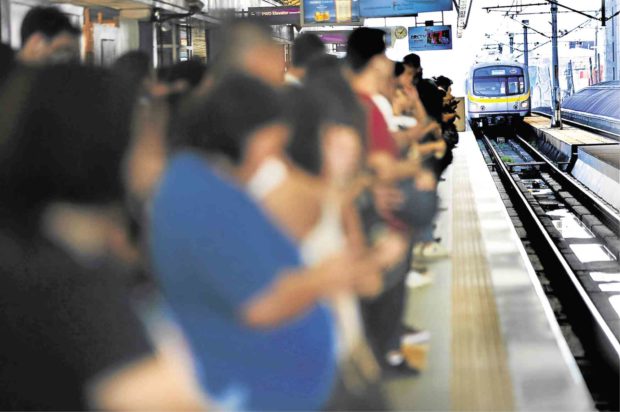LRT 2 still plagued by power concerns

BACK ON TRACK A Light Rail Transit 2 train arrives at the Cubao station on Tuesday, the first day of partial operations after a five-day shutdown. —GRIG C. MONTEGRANDE
MANILA, Philippines — As the Light Rail Transit (LRT) 2 began partial operations on Tuesday following a five-day complete shutdown, the lone train line linking the eastern part of the metropolis to the University Belt area in Manila remains plagued by power concerns.
Starting at 6 a.m., the Light Rail Transit Authority (LRTA) deployed five trains to service eight of its 11 stations—from Recto to Cubao — careful not to trip and overload its remaining four rectifiers (transformers). On a normal day, the LRT 2 services 240,000 commuters between Marikina and Manila.
Its return to service partially eased what Bayan secretary general Renato Reyes referred to on Monday as a “mass transport crisis,” even as the train system’s Santolan to Anonas stations were expected to remain closed for six to nine months.
Significant improvements
In reaction, the Department of Transportation (DOTr) condemned Reyes’ statement as it vaunted the “significant improvements” made across Metro Manila’s railway systems and the ongoing construction of extension lines to improve mass transport.
Article continues after this advertisementRectifiers Nos. 5 and 6, which supplied power to the Anonas-Katipunan stations and the LRT 2’s Santolan depot, respectively, exploded and caught fire on Oct. 3 for yet unknown reasons.
Article continues after this advertisementThe LRTA, however, was especially concerned about rectifier No. 3 at Gilmore Station, which had also tripped the day before the explosion following a lightning strike, according to LRTA spokesperson Hernando Cabrera.
“While we were able to bring back partial operations today, we weren’t able to bring back rectifier No. 3 back to its 100-percent efficiency. It’s why we can only operate five trains. Any more and we are likely to trip and overload the other rectifiers and our operations would be even more imperiled,” Cabrera said.
Revenue hours have also been cut short (between 6 a.m. and 8:30 p.m. from the previous 4:30 a.m. to 10 p.m.) so as not to push the LRT 2’s limited power supply and to make time for the regular maintenance of trains, he added.
For now, the trains undergo routine checkups (light maintenance) at the stations instead of the Santolan depot. As for the heavy maintenance checks, the engineers have to tow the trains one by one to the depot and then back again for a test run before their deployment during revenue hours.
Lucky break
In a way, it was fortunate that at the time the rectifiers blew out, seven of the trains were stranded on the mainline.
Had the trains been parked at the depot, where power had yet to be restored as of Tuesday afternoon, it would have been impossible for the LRT 2 to resume even partial operations, Cabrera said.
Passenger traffic was bearable when the Inquirer visited the Cubao station, which was linked to the Metro Rail Transit (MRT 3). But only one office — the control center that oversees the trains’ operations — at the Santolan depot, had electricity.
For now, the LRTA has turned over the probe of the explosion to the Bureau of Fire Protection while its own commissioning engineers try to work out the logistics to return train operations to normal, Cabrera said.
The commissioning engineers are expected to turn in their report on the explosion today, Oct. 9.
The priority for now, Cabrera said, was to replace the damaged rectifiers, or the huge transformers that serve as both the power supply and the circuit breakers for the trains.
Possible options
One option was to get the rectifiers bought for either the LRT 2 Masinag extension or the common station at North Avenue which would link the LRT 2 to the LRT Line 1 and MRT 3.
It was unclear why the LRT 2 did not have spare parts, Cabrera said.
For now, as a stop-gap measure, the DOTr has deployed around 32 buses with special permits to ferry passengers from Santolan to Cubao until 10 p.m. every day until the reopening of the last three LRT 2 stations.